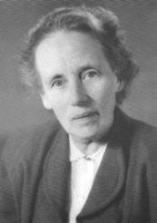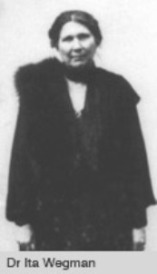What is Rhythmical Massage Therapy?
“The hands are the most formative, most sensitive of our living tools. They can change and transform very much in the course of life.” Dr. M. Hauschka
Rhythmical Massage Therapy was developed in the 1920's by Dr Ita Wegman, a medical doctor schooled in physiotherapy and massage. In collaboration with Rudolf Steiner she founded a clinic in Switzerland where Anthroposophical Medicine began its development. It was at this clinic that she applied an anthroposophical understanding of the human being to therapeutic massage.
After Dr. Margarethe Hauschka joined the clinic, she and Dr. Wegman collaborated for 12 years to develop this new approach to massage therapy. In 1962 Dr. Hauschka opened the first school for Rhythmical Massage in Boll, Germany.
Rhythmical Massage Therapy uses a gentle rhythmical breathing quality of touch which can penetrate the tissue deeply. The movements are rounded with an element of suction rather than pressure and are designed to influence the flow of fluids through the body. It enables the life processes in the tissues to be stimulated and lifted out of gravity into levity.
Rhythmical Massage Therapy aims to address the warmth organisation. During illness the warmth distribution over the physical body is often affected, and this can serve as a diognostic starting point for the massage therapist.
Rhythmical massage differs from other types of massage in that the therapist often works on one part of the body in order to influence another. For example, a complaint of warmth and tension in the head, neck and shoulders can be accompanied by a coldness and lack of presence in the thighs, calves and feet. By bringing warmth to the lower half of the body, tension in the upper half of the body can be relieved.
In most of the treatments a variety of oils and ointments are used. Rosemary may be used on the limbs to awaken and enliven, lavender can be used for symptoms of anxiety and persistent sleeping problems and hypericum (St. Johns Wort) is often used to address the warmth organisation.
It is as if the warming sunlight that forms the plant is transferred from the oil to the body through the massage process. A warming massage with arnica massage balm for example can unlock us from muscle spasm, neck pain, back ache tightness, stiffness. As well as easing common physical aches and pains, rhythmical massage therapy can significantly influence our emotional health, reassuring, reviving and healing.
Rhythmical Massage Therapy is used in an increasing number of clinics and doctors' surgeries around the world to treat a wide range of problems. The massage may be used individually or used alongside physiotherapy and other complementary therapies, but it is usually prescribed by a doctor as part of a total treatment program which may also include natural remedies or conventional medication.
Rhythmical Massage Therapy devises and implements a treatment plan according to the individual needs of the client/patient and his/her illness picture, at times also referring to other health care providers where appropriate.
The therapy process evolves over a period of several weeks. Therapy is given in a warm room with the client well wrapped in sheets or towels. Only the area to be treated is left uncovered. Each session lasts 20 to 30 minutes and is then followed by a rest period of approximately the same duration. The rest period is considered an integral part of the treatment.
Rhythmical Massage Therapy is suitable for children, adults and the elderly. It is particularly beneficial in the treatment of acute and chronic conditions. For example: orthopaedic problems, circulatory problems and pain management. It is also effective in treating psychological conditions such as stress, anxiety, depression, insomnia, emotional trauma and immune deficiencies. It can also be used as a treatment for various life threatening illnesses.
“Through rhythmical massage there is the attempt and aim to improve the connection of soul and spirit to the physical body”
Dr. M. Hauschka


 Margarethe Hauschka
Margarethe Hauschka